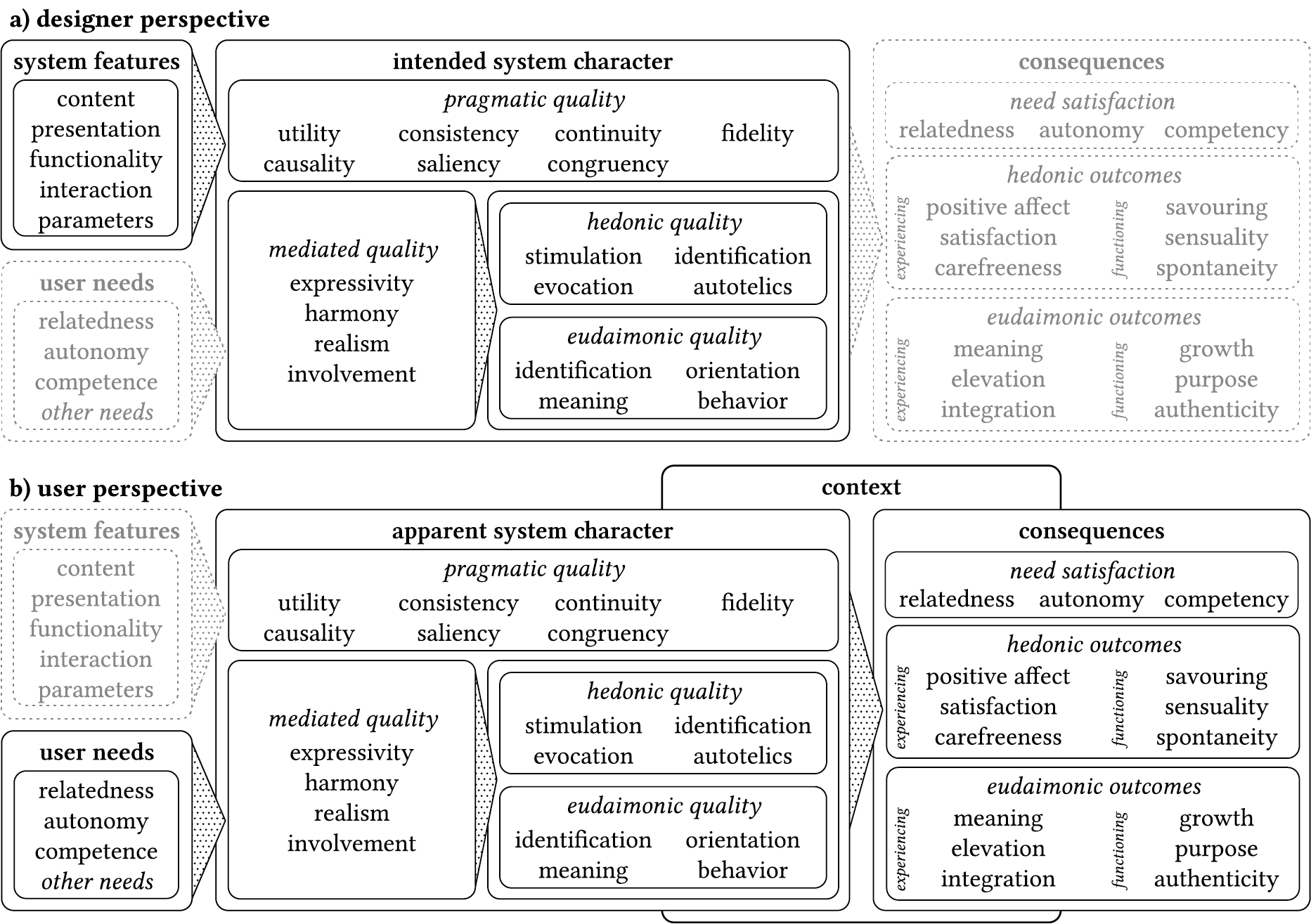A Unified Model for Haptic Experience
In this paper, we examine the current state of Haptic Experience (HX) research, a subfield of User Experience (UX) design that focuses on the sense of touch in human-computer interaction. We analyse existing HX models, identify limitations in their application to haptic experiences, and propose a Unified Model for Haptic Experience that integrates concepts from UX, positive psychology, and haptics research. This new model considers the pragmatic, hedonic, and eudaimonic qualities of haptic interactions, as well as user needs and contextual factors. We also critique prevalent research methodologies, advocating for a shift from a results-centric to a model-centric approach that emphasises a more holistic understanding of haptic experiences. Finally, we propose future research directions for refining the model and exploring ethical implications.
The Current State of Haptic Research
We review current haptic research on the design of haptic experiences and analyse 104 papers in the field. Current haptic research is focused on designing technology-mediated touch feedback, also known as haptic feedback, which has the potential to create meaningful and positive experiences. However, designing effective haptic experiences remains challenging due to the complexity of the haptic senses and the wide array of actuation technologies. Here are key aspects of the current state of haptic research we found through our review:
- Focus on Pragmatic Qualities: Much of the research in haptics concentrates on the pragmatic qualities of haptic systems, such as their utility and usability. Such research evaluates how well a haptic system works as intended, for example, if a system can mimic textures accurately. Researchers often measure the effectiveness of haptic designs by evaluating performance, physiological responses, and the ability of participants to perceive the design’s intention. Efficiency is another common measure, assessing things like task completion time.
- Quantitative Methods: The field relies heavily on quantitative methods to collect data, often using self-developed questionnaires. These questionnaires often focus on measuring constructs such as realism, immersion and enjoyment. Many of these self-developed questionnaires are not well-documented, making it difficult to interpret results.
- Limited Exploration of Hedonic and Eudaimonic Qualities: While there is a growing awareness of the importance of hedonic (pleasure, enjoyment) and eudaimonic (meaning, growth) qualities in UX, haptic research often lacks a deep engagement with these aspects. While some studies measure constructs like enjoyment and fun, they are often superficial and not always based on validated instruments. Studies of eudaimonic qualities are even less common.
The Unified Model for Haptic Experience
The Unified Model for Haptic Experience is a framework designed to help haptic designers and researchers understand the complex nature of haptic experiences and move beyond a focus on pragmatic qualities. It integrates existing models and concepts from UX, haptics, and positive psychology. The model aims to bridge the gap between the design of haptic systems and the user’s subjective experience, with a particular focus on positive experiences.
 Figure. Key elements of the Unified Model for Haptic Experience (HX) are a) a designer’s designer’s perspective and b) a user’s perspective. Iterated from Kim and Schneider’s HX model, informed by Hassenzahl’s model for UX.
Figure. Key elements of the Unified Model for Haptic Experience (HX) are a) a designer’s designer’s perspective and b) a user’s perspective. Iterated from Kim and Schneider’s HX model, informed by Hassenzahl’s model for UX.
The model is intended to provide a vocabulary and a thinking tool for haptic designers and researchers. It encourages a shift from a results-centric approach to a more model-centric one and views the haptic experience as an interconnected whole rather than a feature of a device. We see the model as a starting point for further research. Future work should focus on refining the constructs within the model, addressing ethical considerations, and exploring the diversity of haptic technology users.
Outcomes
- Haptic Experience (HX) as a Subfield of UX: Haptic experience is considered a subfield of UX that addresses the specific challenges of haptics. The design of positive experiences is central to HX research, but the field is still evolving and has not undergone the same iterative development as UX.
- The Challenge of Capturing Haptic Experiences: Haptic experiences are rich, nuanced, and personal, making them difficult to capture and evaluate. Researchers often struggle to move beyond evaluating the pragmatic functionality of a system to understand the felt haptic experience.
- Need for a Paradigm Shift: There is a need for a shift from a result-centric approach, which focuses on whether a haptic stimulus causes a positive effect, to a model-centric approach, which focuses on developing models of how haptic experiences are created. Current research often treats experiences as static and repeatable rather than recognising their dynamic and subjective nature.
-
Open Questions: There are several open questions in haptic research:
- How do hedonic and eudaimonic experiences manifest when using haptic technology?
- What are the long-term effects of haptic technology use?
- How can the field develop a more robust mapping between haptic stimuli and haptic experience?
Read the full paper here: 10.1145/3711842.
Cite this work using the following:
@article{10.1145/3711842,
author = {Dalsgaard, Tor-Salve and Schneider, Oliver},
title = {A Unified Model for Haptic Experience},
year = {2025},
publisher = {Association for Computing Machinery},
address = {New York, NY, USA},
issn = {1073-0516},
doi = {10.1145/3711842},
journal = {ACM Trans. Comput.-Hum. Interact.},
month = jan,
}